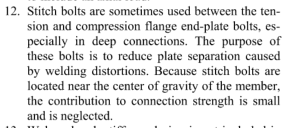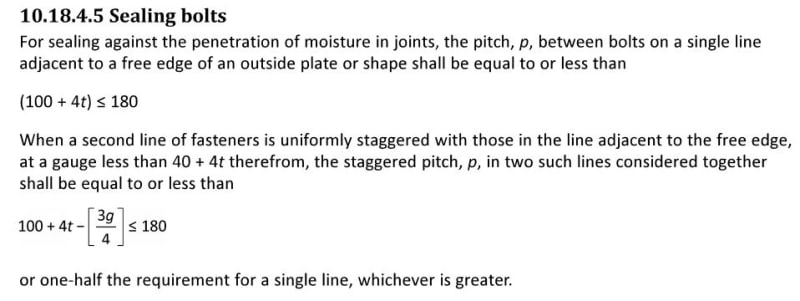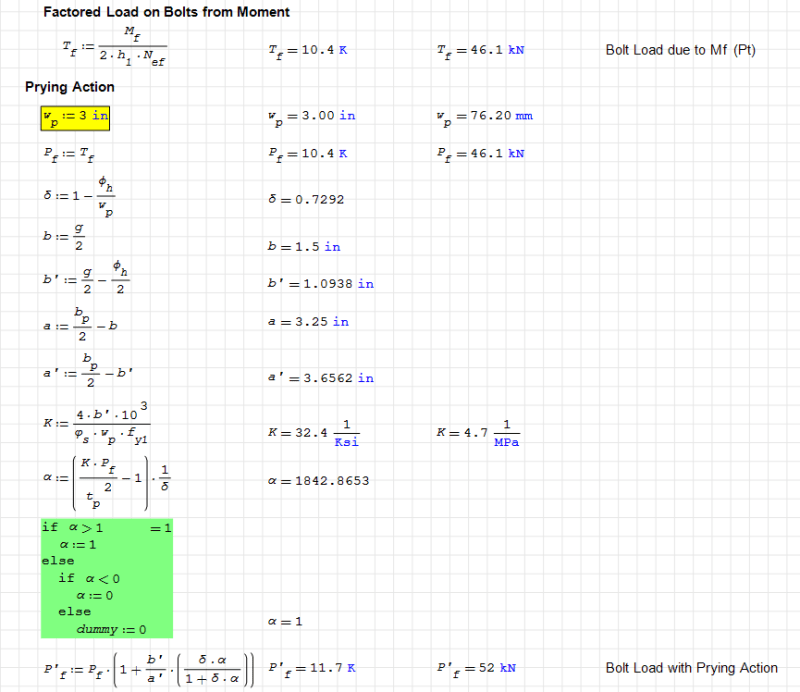Navigation
Install the app
How to install the app on iOS
Follow along with the video below to see how to install our site as a web app on your home screen.
Note: This feature may not be available in some browsers.
More options
Style variation
-
Congratulations cowski on being selected by the Eng-Tips community for having the most helpful posts in the forums last week. Way to Go!
You are using an out of date browser. It may not display this or other websites correctly.
You should upgrade or use an alternative browser.
You should upgrade or use an alternative browser.
Maximum Bolt Spacing 7
- Thread starter dik
- Start date
- Status
- Not open for further replies.
msquared48
Structural
Logically, it seems there should be a maximum vertical distance between the two bottom bolts to minimize prying action to the bolts from any plate bending, or at least a maximum/minimum plate thickness to bolt distance ratio of sorts.
Mike McCann, PE, SE (WA, HI)
Mike McCann, PE, SE (WA, HI)
- Thread starter
- #3
A specific requirement for an end plate connection, or in general? In general, I believe AISC has a 12" rule somewhere...the idea is to ensure sufficient contact between plies to minimize moisture intrusion and the resulting corrosion in concealed areas. It's been a while since I've had to worry about that, though.
- Thread starter
- #5
-
1
- #6
Correction:
I figured you'd need Canadian, but alas...AISC is all I can do for your. Hopefully it'll at least guide your approach a little, or help you find it in the Canadian code. I've come to understand there's a good bit of overlap between the two when we're talking about steel.
AISC 360-10 said:"The longitudinal spacing of fasteners between elements consisting of a plate and a shape or two plates in continuous contact shall be as follows:
(a) For painted members or unpainted members not subject to corrosion, the spacing shall not exceed 24 times the thickness of the thinner part or 12 in.
(b) For unpainted members of weathering steel subject to atmospheric corrosion, the spacing shall not exceed 14 times the thickness of the thinner part or 7 in.
I figured you'd need Canadian, but alas...AISC is all I can do for your. Hopefully it'll at least guide your approach a little, or help you find it in the Canadian code. I've come to understand there's a good bit of overlap between the two when we're talking about steel.
-
1
- #7
Clause 22.3.3: Maximum edge distance MIN of 12t or 150mm (6")
I think this is the closest item to apply in S16. It's a function of the thickness of the members joining to make sure there is contact. Contact is then dependent on rolling tolerance of the mating members.
If you are attaching two plates with bolts 12" apart ... there's something special going on there. So I think 6" is a reasonable upper limit without some judgement applied.
S16 used to have a clause that defined a reduction length for long lap connections. This is seen in the commentary for Clause 12.3.3 in S16-14. I believe the upper limit was actually 600mm before the reduction starting being applied. However, it does suggest that it is a shear lag issue with bolts being THAT far apart. I would cut it off at 6" and call it a day.
I think this is the closest item to apply in S16. It's a function of the thickness of the members joining to make sure there is contact. Contact is then dependent on rolling tolerance of the mating members.
If you are attaching two plates with bolts 12" apart ... there's something special going on there. So I think 6" is a reasonable upper limit without some judgement applied.
S16 used to have a clause that defined a reduction length for long lap connections. This is seen in the commentary for Clause 12.3.3 in S16-14. I believe the upper limit was actually 600mm before the reduction starting being applied. However, it does suggest that it is a shear lag issue with bolts being THAT far apart. I would cut it off at 6" and call it a day.
- Thread starter
- #8
Thanks, gentlemen... that' s the edge distance, not the spacing. I think I'll run with the AISC... if I cannot find anything different.
Rather than think climate change and the corona virus as science, think of it as the wrath of God. Feel any better?
-Dik
Rather than think climate change and the corona virus as science, think of it as the wrath of God. Feel any better?
-Dik
-
1
- #9
- Thread starter
- #10
Thanks, fox... I'm debating adding an extra line of bolts. Corrosion is not an issue and the conections are at a fairly stiff area of the end plate. I really don't think they are necessary and cannot understand why the AISC would require this. I'm waiting to hear back from the CISC to see if they have any comments.
Rather than think climate change and the corona virus as science, think of it as the wrath of God. Feel any better?
-Dik
Rather than think climate change and the corona virus as science, think of it as the wrath of God. Feel any better?
-Dik
-
1
- #11
I checked the commentary, but it's not helpful. Just explains what maximum spacing means - not why the limits are what they are. For connections not subject to corrosion, I'm guessing it has to do with stability of the connected plates. If we dig into it far enough, we'd probably find that at least one of the calculation methods listed in AISC assumes a certain unbraced length for the plates based on their thickness - somewhere in the neighborhood of 24t. So they put in this prescriptive requirement to ensure the calculation assumptions are met. Just a guess.
- Thread starter
- #12
-
1
- #13
I think widely separating the bolts means you need to consider them as individual loadpaths, which may affect things. For example, with a set of bolts you could say "these react the shear, and the outer pair react the bending".
I'd be concerned about the two plates fretting where they aren't well constrained (between the widely spaced bolts). Particularly if flat plates, a stiffener would help but more hassle than adding a few bolts.
another day in paradise, or is paradise one day closer ?
I'd be concerned about the two plates fretting where they aren't well constrained (between the widely spaced bolts). Particularly if flat plates, a stiffener would help but more hassle than adding a few bolts.
another day in paradise, or is paradise one day closer ?
-
1
- #14
It looks like AISC Design Guide 16 on Extended End Plate Moment Connections uses a distance between bolts of greater than 12" for the examples used. They didn't consider or mention adding bolts. The only thing they mention about bolt spacing is the following snippet from page 13 (Additional assumptions):

The PEMB business regularly exceeds the 12" maximum distance. I've thought the maximum bolt spacing is for bolts that are considered to act together. Since your tension bolts take all the tension load, and your compression zone bolts take the shear (i.e. you're not mixing shear resistance between bolts at the top and bottom of the connection), I would think the max spacing wouldn't apply for this connection type.
Go Bucks!

The PEMB business regularly exceeds the 12" maximum distance. I've thought the maximum bolt spacing is for bolts that are considered to act together. Since your tension bolts take all the tension load, and your compression zone bolts take the shear (i.e. you're not mixing shear resistance between bolts at the top and bottom of the connection), I would think the max spacing wouldn't apply for this connection type.
Go Bucks!
-
1
- #15
dik, the only Canadian guidance on maximum bolt pitch, that I know of, is in S6. See clipping below of relevant clause. Again, this has to do with sealing the two plates, which doesn't seem to be a concern in your case.
I had a recent job where we were replacing a pre-eng roof beam with a similar end plate to what you show in your first post - your typical run of the mill pre-eng end plate. When it was installed I got a call that after tensioning all of the bolts, the plate in the mid-depth portion of the beam hadn't drawn tight. Granted, the end plate was about as flimsy as could be, which isn't a surprise for a pre-eng connection. If given the option, I would add some additional bolts in that part of the end plate if for nothing else than it looks right.

I had a recent job where we were replacing a pre-eng roof beam with a similar end plate to what you show in your first post - your typical run of the mill pre-eng end plate. When it was installed I got a call that after tensioning all of the bolts, the plate in the mid-depth portion of the beam hadn't drawn tight. Granted, the end plate was about as flimsy as could be, which isn't a surprise for a pre-eng connection. If given the option, I would add some additional bolts in that part of the end plate if for nothing else than it looks right.

- Thread starter
- #16
It looks like AISC Design Guide 16
that's what I'm basing it on... rather than bolted end plate, they want to do field weld CJP welds... and were taken back a bit when I told them all welds would have to be x-rayed...
that I know of, is in S6
Thanks Canpro... actually have a copy of that somewhere... will dust it off...
Rather than think climate change and the corona virus as science, think of it as the wrath of God. Feel any better?
-Dik
- Thread starter
- #17
Got a response from the CISC, and there doesn't seem to be... he mentioned the AISC DG for plated end connections without noting that they don't seem to follow their own guidelines... The client wants to use field welded CJP welds... his call...
Rather than think climate change and the corona virus as science, think of it as the wrath of God. Feel any better?
-Dik
Rather than think climate change and the corona virus as science, think of it as the wrath of God. Feel any better?
-Dik
Hi dik
The link below is to the Roymech site dealing with bolted joints, if you scroll down to the title were it deals with joint stiffness you will see diagrams showing a pressure cone radiating from under the bolt head, when I had a joint with a gasket I made sure that the pressure cones between two bolts over lapped to ensure the gasket was held firm, I realise that your joint probably isn’t that critical.
“Do not worry about your problems with mathematics, I assure you mine are far greater.” Albert Einstein
The link below is to the Roymech site dealing with bolted joints, if you scroll down to the title were it deals with joint stiffness you will see diagrams showing a pressure cone radiating from under the bolt head, when I had a joint with a gasket I made sure that the pressure cones between two bolts over lapped to ensure the gasket was held firm, I realise that your joint probably isn’t that critical.
“Do not worry about your problems with mathematics, I assure you mine are far greater.” Albert Einstein
- Thread starter
- #19
Excellent article... thanks... clamping is not an issue... if corrosion were at play, then, yes. On a project in Windson, the engineer in charge for the client eliminated the viton gaskets for the stack because the fasteners were so close together... guess what leaked... I wasn't asked but it seemed reasonable.
That was one of those 'perfect' projects that went flawlessly... everything went perfectly... The client implimented my Excel shop drawing recording for future work (I didn't think it was unusual for large projects). We had an opportunity to do a large VOC (34' dia) mech addition x 600' long that we lost simply because the manager of that department would not return phone calls because he didn't know who the client was (It was a 'shoe in' because the project went so flawlessly, and he couldn't be bothered... one of the few times I've ever been really p*ssed off).
Rather than think climate change and the corona virus as science, think of it as the wrath of God. Feel any better?
-Dik
That was one of those 'perfect' projects that went flawlessly... everything went perfectly... The client implimented my Excel shop drawing recording for future work (I didn't think it was unusual for large projects). We had an opportunity to do a large VOC (34' dia) mech addition x 600' long that we lost simply because the manager of that department would not return phone calls because he didn't know who the client was (It was a 'shoe in' because the project went so flawlessly, and he couldn't be bothered... one of the few times I've ever been really p*ssed off).
Rather than think climate change and the corona virus as science, think of it as the wrath of God. Feel any better?
-Dik
- Status
- Not open for further replies.
Similar threads
- Replies
- 4
- Views
- 3K
- Locked
- Question
- Replies
- 0
- Views
- 1K
- Locked
- Question
- Replies
- 0
- Views
- 1K
- Replies
- 1
- Views
- 1K
- Locked
- Question
- Replies
- 2
- Views
- 1K


